Contents
Pear “Victoria”, zoned in the climatic conditions of the North Caucasus and the forest-steppe zone of Ukraine, was obtained by hybridization. The variety was created on the basis of the winter Michurin “Tolstobezhka” and the French “Bere Bosque”. The originators of the variety are a group of breeders from the Melitopol Experimental Station led by A. Avramenko. The description, photos and reviews of the pear “Victoria” corresponded to the characteristics declared by the authors, in 1993 the variety was entered into the State Register.
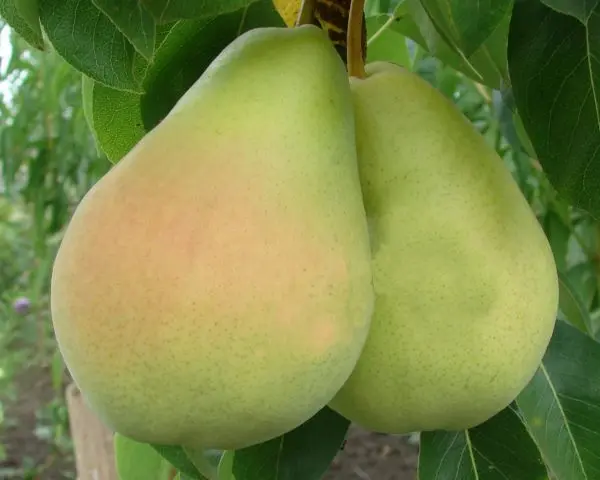
Description of the Victoria pear variety
The culture belongs to the late summer ripening period, the biological ripeness of the fruits reaches in mid-August, early September. The precocity of the pear “Victoria” is average, bears fruit after planting for 6 years. The flowering period falls at a time when the threat of repeated spring frosts has passed. Weather conditions do not affect the formation of the ovary. The pear is characterized by consistently high yields. From the Tolstobezhka variety, the pear inherited frost resistance, from the Bere Bosk variety – a high gastronomic assessment.
External description of the pear “Victoria”:
- The height of the fruit tree reaches 5 m, the crown is sprawling, of medium density, rounded pyramidal shape. The trunk and perennial branches are painted dark brown, young shoots are burgundy, after a year of vegetation they acquire a common color with the central trunk.
- The leaves are dark green with a glossy surface in the form of an elongated oval, tapering at the top. On young shoots, the leaves are brown with a red tint, as they grow, they take on the color of the main crown.
- Vegetation and flowering period – the second half of May. It blooms profusely, with white flowers collected in inflorescences on annuli. The flowers completely remain on the fruit tree, do not fall off. Formation of ovaries – 100%.
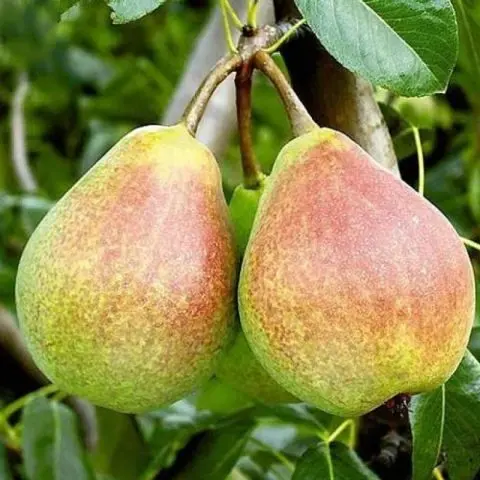
Fruit Characteristics
Due to the taste, juiciness and aroma of fruits, the Victoria pear belongs to dessert varieties. This is one of the few types of culture that produces a large number of parthenocarpic (seedless) fruits. The pear variety ripens at the end of summer, the fruits are stored for a long time. The structure of the pear is loose, it is rarely used for preservation for the winter, it is often consumed fresh.
Description of the fruits of the pear “Victoria” (shown in the photo):
- the shape is symmetrical, regular, pear-shaped;
- peduncle curved, short, thin;
- dominated by large ones, weighing about 260 g, there are medium-sized 155 g;
- the peel is smooth, at the stage of technical ripeness it is green with brown patches, by the time of ripening it acquires a yellow tint, the dots darken;
- red continuous pigmentation (blush) covers one side of the pear;
- the surface is not bumpy smooth;
- the pulp is oily, loose texture, juicy, without granulation, aromatic;
- the taste is sweet, the concentration of titratable acids is minimal;
- the fruits are well fixed on the stalk, not prone to shedding.
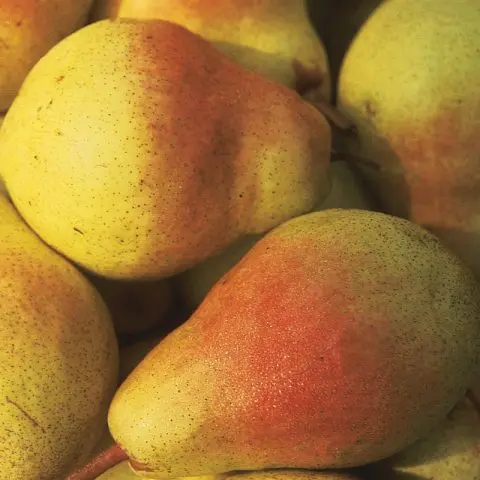
Pros and cons of the variety
The pear of the elite dessert variety “Victoria” is grown for personal consumption and for commercial purposes. The variety has the following advantages:
- stable fruiting, good yield;
- high gastronomic appreciation;
- presentable trade dress;
- frost resistance;
- the ability to do without watering for a long time;
- stable immunity against scab and garden pests;
- long-term storage.
The conditional disadvantages include a decrease in glucose in a pear with a deficiency of ultraviolet radiation. The taste of the fruit will be more sour.
Optimal growing conditions
The fruit crop was bred for cultivation in the North Caucasus region, in Ukraine, cultivation is allowed in Belarus. Pear “Victoria” refers to the southern varieties. The ability to withstand frost is not great enough to grow a crop in a temperate climate.
The variety brings a stable crop, provided that the tree is located on the site correctly and the soil requirements are met. For full photosynthesis, the Victoria pear requires a sufficient amount of ultraviolet radiation. In a shaded place, fruits with a small mass and sour taste grow. Young shoots are weak, elongated, flowering is plentiful, but some of the flowers will fall off.
The optimal part of the site is the south or east side, protected from drafts.
The soil for the Victoria pear is preferably neutral, sandy, loam is allowed. If there is no choice and the pear will have to be planted in acidic soils, neutralization is carried out in the fall with dolomite flour or lime. The variety tolerates water deficiency more easily than waterlogging the soil. Pear “Victoria” can not be placed in lowlands where precipitation accumulates, as well as in a site with closely occurring soil water.
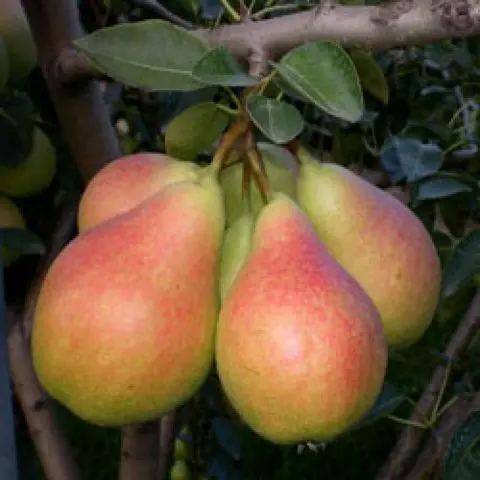
Planting and caring for Victoria pear
Pear “Victoria” is planted in spring or autumn. The culture is intended for cultivation in warm climates, so the spring planting method is rarely used. A pear is determined for a permanent place of growth 3 weeks before the onset of frost, approximately in mid-October.
Planting material is chosen one-year-old, with a well-developed root system. Dry and damaged fragments are removed before planting. The bark on the seedling should be smooth, dark in color, without mechanical damage, with a pronounced seal located above the root.
Rules of landing
The landing pit (90*80 cm) is prepared a week before the scheduled work. A fertile mixture is prepared, consisting of the top layer of soil, sand and organic matter in equal proportions. A potassium and phosphate based agent is added to the mixture. The root of a pear seedling is dipped for 3 hours in a solution of “Epin”, which stimulates growth.
Landing sequence:
- To fix the seedling, a stake is driven into the recess.
- Pour ½ of the mixture into the bottom of the pit in the shape of a cone.
- The seedling is placed, evenly distributing the root over the pit. If the planting material was in a container, the fertile mixture is poured in a layer, the root, together with an earthy clod, is placed in the center.
- The remaining mixture and soil are poured on top.
- They fix it to a support, ram the root circle.
- Abundantly watered.
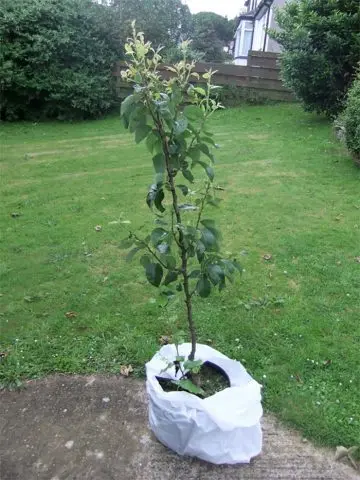
Watering and top dressing
Pear “Victoria” is not an early-growing variety, the first harvest gives in the sixth year of growth. After planting, fertilizing the culture is not required. Water the pear during a dry summer once a month. If the season proceeds with periodic precipitation, additional watering is not required.
Feed the pear at the time of flowering with nitrate or urea. Before the formation of fruits, “Cafor K” is used, during the ripening period – magnesium sulfate. In autumn, they loosen the soil near the tree, remove weeds, add organic matter, and mulch. Acidic soils are neutralized with lime (1 time in 4 years).
Trimming
Pruning pear “Victoria” is carried out next spring after the autumn planting. Shorten shoots by 1/3. Subsequent pruning provides for the formation of a crown in the third year of vegetation:
- The lower branches are straightened to a horizontal position, fixed. They will go to the first circle of skeletal branches.
- The next spring, they are shortened by ¼ of the length, the tops are wringed by autumn.
- The second skeletal circle is formed from two branches; they should be shorter than the previous circle.
- The last tier consists of three annual shoots, they are shortened according to the previous scheme.
By five years of growth, the pear crown looks like a rounded cone; cardinal pruning is no longer needed. Every spring, sanitary cleaning is carried out, excess shoots, dry branches are removed, young shoots are cut off near the root.
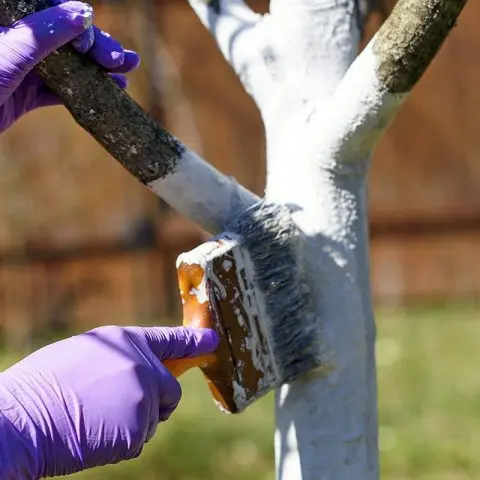
Whitewash
White pear “Victoria” in spring and autumn about 1 meter from the ground. Use lime, acrylic or water-based paint. The event is sanitary in nature. In the bark of the tree, larvae of insect pests and spores of the fungus hibernate. After processing, they die. Whitewashing protects the wood from ultraviolet burns.
Preparation for winter
The pear “Victoria” grows in regions with a warm climate, it genetically contains sufficient resistance to frost, which is enough for the culture to winter safely. The young tree is not covered. With a shortage of seasonal precipitation, the pear is plentifully watered, mulched with dry sawdust, old leaves or peat.
Pollination
The pear variety “Victoria” blooms with female and male flowers. A self-fertile crop can do without pollinators. The yield will be higher if varieties that are identical in flowering time with Victoria grow nearby on the site. As a pollinator, a pear “Triumph of Vienna” or “Williams Red” is suitable.
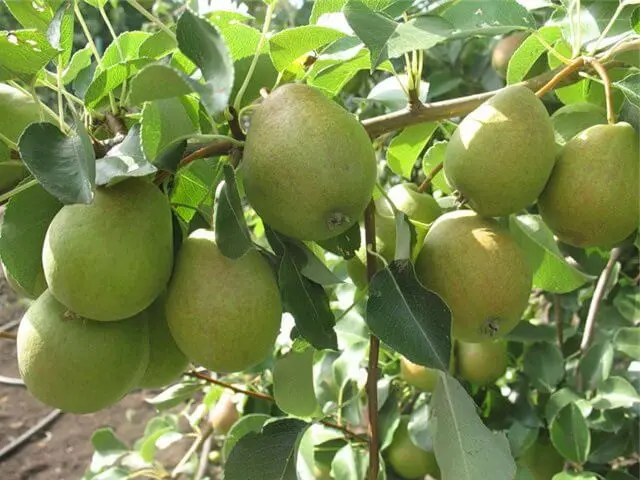
Productivity
When pear blossoms, all flowers remain on the tree, do not crumble. The variety does not lose part of the ovaries, they ripen completely. If the tree grows in an open sunny area, the yield is about 160 kg. Increased rates (up to 180 kg) are observed if the summer was hot and not rainy.
Diseases and pests
The most common fungal infection on fruit crops is scab, but the Victoria pear is resistant to infection. Diseases affecting the variety:
- Moniliosis. It manifests itself as dark spots on the fruits, causing their subsequent rotting. Sick pears do not fall from the tree and infect the rest. To prevent the infection from spreading, damaged fruits are removed.
- Mučnistaâ rosa covers the entire tree in the form of a gray coating. To combat the disease, damaged dry areas are removed, and the crown is treated with “Sulfite”, “Fundazol”.
- black cancer, is rare, the primary focus of infection appears on the bark of a tree in the form of corrosion. Without treatment, the infection spreads to the crown. Spray the culture with preparations containing copper. In autumn, leaves and dry branches are burned.
- parasitic insects on the variety “Victoria” a little. The brown fruit mite is removed in the spring with Oleocuprite, Nitrafen. In summer, the pear is treated with “Acartan” or colloidal sulfur. They get rid of the leaf gall midge with Zolon, Nexion, Karbofos.

Victoria pear reviews
Conclusion
Description, photos and reviews about the pear “Victoria” will help to get an overall picture of the variety, the data is fully consistent with the declared characteristics. The variety is drought-resistant with excellent gastronomic qualities, good immunity to fungi, and is practically not affected by pests. The fruit tree is undemanding to care.









